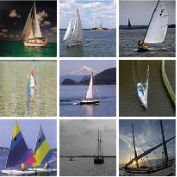In the image classification task, the most common approach is to resize all images in a dataset to a unique shape, while reducing their precision to a size which facilitates experimentation at scale. This practice has benefits from a computational perspective, but it entails negative side-effects on performance due to loss of information and image deformation. In this work we introduce the MAMe dataset, an image classification dataset with remarkable high resolution and variable shape properties. The goal of MAMe is to provide a tool for studying the impact of such properties in image classification, while motivating research in the field. The MAMe dataset contains thousands of artworks from three different museums, and proposes a classification task consisting on differentiating between 29 mediums (i.e. materials and techniques) supervised by art experts. After reviewing the singularity of MAMe in the context of current image classification tasks, a thorough description of the task is provided, together with dataset statistics. Experiments are conducted to evaluate the impact of using high resolution images, variable shape inputs and both properties at the same time. Results illustrate the positive impact in performance when using high resolution images, while highlighting the lack of solutions to exploit variable shapes. An additional experiment exposes the distinctiveness between the MAMe dataset and the prototypical ImageNet dataset. Finally, the baselines are inspected using explainability methods and expert knowledge, to gain insights on the challenges that remain ahead.
翻译:在图像分类任务中,最常用的方法是将数据集中的所有图像调整成一个独特的形状,同时将其精确度降低到便于规模实验的大小。这种做法从计算角度获益,但因信息丢失和图像变形而给业绩带来消极的副作用。在这项工作中,我们引入了MAME数据集,即图像分类数据集,该数据集具有显著高分辨率和可变形状特性。MAME的目标是提供一个工具,用于研究图像分类中这类属性的影响,同时鼓励实地研究。MAME数据集包含来自三个不同博物馆的数千件艺术品,并提出了由艺术专家监督的29种介质(即材料和技术)的分类任务。在审查了MAME在当前图像分类任务中的独特性之后,提供了任务的全面描述,同时提供了数据集统计数据。进行了实验,以评价使用高分辨率图像、可变形状投入和同一时间的属性的影响。结果显示在使用高分辨率图像时的性能产生的积极影响,同时强调缺乏利用可变式图像的解决方案,同时强调利用可变式模型的模型和最终的模型分析方法。



